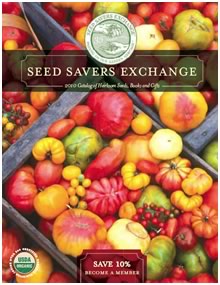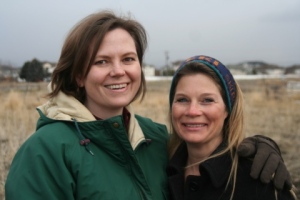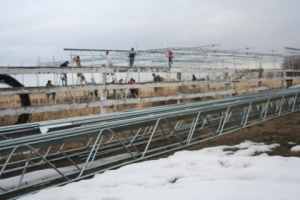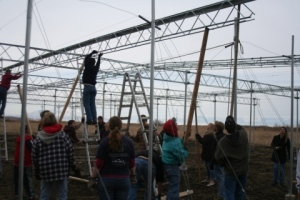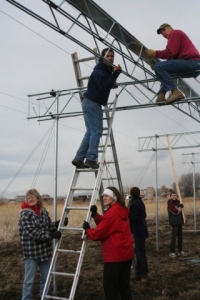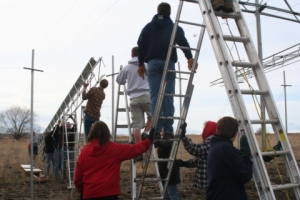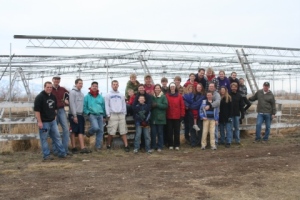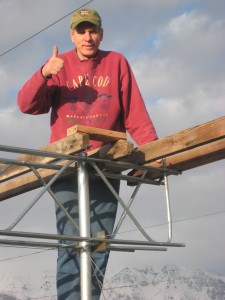Please go to http://www.eatwhatsreal.com/blog/ for the latest news from Jacob’s Cove Heritage Farm.
The Most Wonderful Time of the Year
As a child I loved thumbing through catalogs and making a Christmas list. My siblings and I would bunch together on our blue floral couch to see what wonderful things were available for the season. There were the inevitable fights when more than one of us wanted the same thing. It all ended well on Christmas morning when we were surprised to find that Santa brought us things we didn’t even know we wanted.
These days my favorite catalogs contain seeds and pictures of beautiful plants. This is much harder than choosing a Christmas gift. Now I have to commit to a limited variety of foods for an entire season! We plant a lot of different varieties of a lot of different foods but when you start looking at seed catalogs you can see that even if you plant 10 different lettuce varieties there are still hundreds you’ll not get to taste this year.
I prefer heirloom seeds for a lot of reasons but I’m not against a good hybrid now and then. Just understand that when you plant that hybrid you won’t be able to save the seed and grow the same fruit next year. But if saving seed isn’t an issue for you, you’ll find a lot of good seed to choose from.
Here are a few of my favorite seed sellers:
Seed Savers Exchange is an incredible farm dedicated to the preservation of heirloom seeds. You can become a member of SSE and will have access to their “yearbook” which is a directory of other members who have heirloom seed they are willing to sell and share. Plus your membership gives you a 10% discount on seeds. Visit them at www.SeedSavers.org
Territorial Seed Company has an extensive collection as well as tools for gardening and preserving the harvest. Visit them at www.TerritorialSeed.com
Johnny Seeds has a great seed collection plus a lot of innovative tools. Some tools are exclusively theirs and designed by farmers such as Eliot Coleman. If you don’t know what “soil blocks” are, and you want to start your own seeds, I suggest you visit www.JohnnySeeds.com They’ve got a lot of free advice and videos to demonstrate the tools. All seed starting supplies are on sale this month.
Seed sellers are more than willing to send you a free catalog. The selection extends far beyond what any local garden center can offer. I love perusing the catalogs during dark winter days and dreaming of dirt and spring sunshine. The best part is that I’ll get exactly what I want.
Meal Maps
Have you thought, recently, about where your food comes from? When you sit down at your next meal see if you can determine the origin of each item. It’s a lot more difficult than I thought it would be.
Carlyn is a graduate student at the U. I met her a few weeks ago when she came to interview Dale and I as research for her thesis. She has a very interesting major that I had never heard of before: Community Art. From what I understand, a community artist does art in the community or creates it with help from the community.
Carlyn has been coming over to our house once a week to teach my children about art and especially about maps. Maps have never been particularly interesting to me until a few weeks ago. We began with the children drawing a map of their bedroom. We then went into the bedroom to see if they had remembered to include everything. Dale and I had switched rooms with the kids so they easily forgot to include several items like a sibling’s bed and where the toys were kept.
They were then instructed to add lines to show where they went when they got up that morning. This trail showed the different habits of each child. The one who hops out of bed and gets dressed had a very different trail from the one who goes directly to the kitchen table. In this way the map began to tell the story of our morning instead of just showing where things belong.
The next week we made a map of all the places where we purchase food: Real Foods Market for raw milk, Walmart for lots of price matched produce, Sunflower Market for greens and Macey’s for the occasional apple fritter. Looking at the map told us where we bought our food but it didn’t tell the full story. Where was the food before it got to the store?
Carlyn had a birthday last week so the kids wanted to do something special for her. The original plan was to make a meal and then map where all the ingredients came from. That proved to be more than this mom could handle so we just made a dessert. As I brainstormed with the kids about what to make it became evident that I probably couldn’t track down the origin of all the ingredients. Where did the wheat come from that made the flour? From what country was the sugar imported? The nuts – where were they from? It became abundantly clear that I am terribly disconnected from my personal food chain.
We ended up serving her zucchini bread we had in our freezer from last summer. (I think that’s the bet way to store zucchini.) We topped it with sweetened, strained yogurt we’d made from our raw milk from Redmond Heritage Farm. Nestled into the creamy white yogurt were thawed cherries that we’d stored in the freezer from our abundant crop last summer. It was simple, delicious and beautiful. Best of all, I knew where most of it had come from.
This new perspective on the diversity of my food choices has given me a new appreciation for the abundance I enjoy. Now I feel a greater call to be a better steward of my meals. And, of course, to eat what’s real.
Compared to What?
The first time we went to a farmers market we were trying to sell our tomatoes for $3 a pound. We were there because we couldn’t eat all the fruit coming off my husband’s 600 heirloom tomato plant experiment. We thought we’d give the farmers market a try.
It was a tough sell. We were at the Thanksgiving Point Friday night farmer’s market next to a farmer selling tomatoes for $5 a box. Granted, his were not heirlooms and neither were they organic but the customers didn’t seem to mind. We did sell over 100 pounds but had a lot of leftovers.
The next morning Dale headed to Salt Lake to try the downtown farmer’s market. He also decided to try to sell for $4 a pound. It was a cool and rainy morning. I was at home with the baby when I received a call from Dale around 8:30 a.m. “Get out to the garden!” he yelled. “Pick anything with color. They’re buying it all!” I rushed outside in the rain and began picking frantically. I packed up the baby and we drove to Salt Lake to deliver the additional fruit. We sold it all.
Year after year we grow and sell to our customers. Like most farmers we have our ardent fans who tell us they come to the market just to buy our tomatoes. And, like most farmers, we have people who are not our customers tell us that we are too expensive. $4 a pound for tomatoes did seem like a lot of money until I was the one out there in the garden at 5 a.m. on a summer morning while my neighbors slept in. It seems expensive until your husband spends the night out knocking snow off the plastic tunnels protecting the seedlings in April. He’s not just protecting his tomatoes he’s protecting your food! When it’s your children standing out in an October rain to service farmer’s market customers $4 a pound seems like a deal.
Why is it that real food is so seemingly expensive? A significant part of the answer is U.S. government farm policy. We pay farmers to overproduce genetically modified corn which is not suitable for human or animal consumption. The farmer grows it at a loss and relies on taxpayer subsidies (read “you and me”) to give him his “profit.” This corn is fed to cows in feed lots to produce sickly and cheap industrial beef. This corn is also turned into corn syrup and added to almost every processed food without exception.
Between 1985 and 2000 the price of a soft drink decreased 25% while the prices of fruits and vegetables during the same time increased 40% (when adjusted for inflation). One is subsidized and makes us sick and the other is not and does not. This isn’t just bad farm policy it’s a recipe for the health care disaster we’re seeing right now.
But how do corn subsidies translate into why local food is expensive? The corn creates an illusion of cheap food. When you say that real food is expensive you are comparing it to something. The food you are usually comparing it to has no real relationship to real food. The comparison is usually between apples and oranges even though they both look like tomatoes. If we calculated the real cost of real food to the real cost of fake food there would be no comparison.
So when you think real food is expensive, ask yourself, “Compared to what?”
Remember, eat what’s real.
News Story on KSL
Yesterday we got a call from KSL News Radio. They interviewed Dale and created a short story about Community Supported Agriculture and Jacob’s Cove. The radio story was very short but there is a longer article online. You can read and hear it HERE.
Since KSL is heard all along the wasatch front we hope that other CSA’s get some attention from the story as well. It’s a good reminder for veggie lovers to get their shares while they can. Thanks KSL!
Why I love (the idea of) Hamburger Helper
A year and a half ago I went with my sisters to a presentation to learn the virtues of shopping with coupons. We left with visions of full shopping carts and full wallets dancing in our heads. We jumped in feet first. We purchased our binders and baseball card organizers, ordered 5 copies of the local Sunday paper, and waited with bated breath until that first load of coupons arrived.
One of my first shopping trips included loading up on a package I had seen but never eaten: Hamburger Helper. As I stacked the boxes in my food storage room my daughter came in and asked what it was. I didn’t quite know what to say. Should I tell her it’s food? Should I explain the economics that made this a justifiable (in my mind) action? Packaged foods were new to my kids and thus held an excitement that a tomato sandwich didn’t. I did tell her that this package was for “emergencies” and not something we would probably eat before the millenium.
It was 5:50 in the evening, nothing prepared for dinner and we had Cub Scout Pack Meeting at 6:30. This was an emergency! I decided try some Hamburger Helper, just once. Once was enough. I fell in love. All you do is brown a pound of hamburger, pour in water, milk and a packet of powder with ingredients you can’t pronounce, and wallah! Dinner is served.
By this time my kids were too smart about real food and recognized Hamburger Helper for what it was. “I can’t eat this,” my son informed me. “It’s junk.” “This is dinner. Eat it.” was my reply. It was edible (sort of) and CHEAP.
I was trying to convince myself that I only pay for my food once – when I take it from the store. Any of us who have reached a level of logic have noticed that we pay for our food in a multitude of ways, the least of which is money. We pay via medical bills, poor relationships, low energy, bad tempers, PMS and ultimately our lives.
As my coupon adventure continued I brought case after case of food into my home that I swore I would only feed my family “in case of emergency.” But, as all mother’s know, emergencies are part of the everyday life of a family. Our diet became more and more processed while our bellies (and other body parts) got bigger and bigger, our energy plummeted and we craved these packaged foods more and more.
Eventually I had to say goodbye to my Hambuger Helper and coupons altogether. I’m not one of those gals who can get a stack of coupons and just cut out the “healthy ones.” I actually don’t think any of those gals exist. We want to save money and live within our family budget and allow our family to thrive all at the same time. I’ve discovered is that it doesn’t take a lot of cheap food for that to happen . It takes real food, in moderation and prepared with care that creates the balance that helps a family to thrive. It takes a thoughtful approach to what I am feeding my family. It’s not cheap but it’s enjoyable and it sure tastes better. In the long run I believe that eating real food is the most cost effective way to feed my family. I’d rather pay a farmer than a doctor.
Community
I grew up in a house at the end of a cul-de-sac. Almost every house had a child of some age. We all went to school during the day but in the afternoon we would congregate in the middle of the street to play kick ball, go catch dragon flies in the old church yard or go into a basement to play a game. When it was time for dinner my mom would come outside and ring a cow bell. It would echo through the neighborhood, into basements and even to the ditch in the church yard to call us home. That childhood neighborhood was the closest thing I’ve ever experienced to a community.
We knew all about each other. We knew how to get under each other’s skin, we knew more about each others parents lives than our parents did, and we knew who was likely to trade a loaf of homemade bread for a Twinkie. It felt real and it felt safe.
The photo above is of me (left) and Annie. Annie showed up a couple weeks ago out of the blue. She approached Dale, who was working on the greenhouse, and asked how she could help. She had recently read the book “Animal, Vegetable, Miracle” by Barbara Kingsolver and wanted to find real food. That’s what led her to us. Since that time she has gone door to door telling her friends about our farm. You might see a flier about us in a few stores about town; those were put there by Annie. She and her husband were also here on Saturday to help with the barn raising. Her tireless energy and desire to create something better in this valley has inspired me and reminded me how important this is.
After the article in the Daily Herald ran yesterday the phone began to ring, which was expected. Then the door bell rang, which was unexpected. I was still in my bathrobe and luckily my husband was available to answer the door. A man had read the paper and wanted to come see the place. He handed Dale a check for his CSA share and told him to be sure and call when he needed some volunteer help. We certainly will.
When I say that I want to build the community I mean that I want to know people in a real way. To do that I have to let people into my life. That’s a little scary but I believe that ultimately it will make for a richer life. I want my neighbors and members of the Jacob’s Cove community to feel welcome in my home. I want to tell a neighbor to call me when they need volunteer help and have them know that I’m sincere.
I want Jacob’s Cove to be a place where the kids can play kickball, the adults can share what’s important to them and we can all be courageous enough to let other people into our lives. That’s where community is built.
Article in The Daily Herald
If you haven’t read it yet, here’s the article from the Sunday Daily Herald.
The Beams Are UP!!!
As I drove towards our farm this morning I can’t tell you how incredible it was to see the street lined with cars and people out lifting beams onto the greenhouse.
By the time I arrived the first set of beams was up and they were preparing to lift the gutters.
The day was cold. We were hoping for sun but instead we got clouds. The ground was wet but not muddy like it was a week ago.
We had a great turnout. Friends, neighbors, customers, supporters and family all pitched in. We needed each one of them. When taking on a task like this each person is so valuable. Some were able to lift, others steadied ladders, still others entertained my children inside the house. We couldn’t have done it without each one of you.
A reporter from the Daily Herald stopped by with a photographer. He was familiar with the CSA concept excited to see one being developed in Utah Valley. We’re grateful for the opportunity to get the word out.
The first set of beams were placed on 2×4’s and pushed up to the top of the structure.
They were then pushed into place. (These are 2 of my nephews working with their Dad. I love seeing families working together.)
Even carrying the beams into place is a big job. Men, women and children all contributed what they could to the effort.
Dale oversaw and tried to make improvements to the process.
Towards the end I heard someone say, “Less talkie more pushie.” Eventually, brute force saved the day. Pushing the beams into place was a huge effort.
The weather held off as we pushed and pulled everything into place.
This is the final group photo. Others came early and had to leave. Some of us came late and stayed. Others came late and left early. Thank you from from the bottom of our hearts for coming at all.
Why did we do this? Because real food is that important. And so is building community.
We’re Ready!
Putting up a greenhouse is an adventure; a long, slow adventure. We began construction on this structure last fall in Pleasant Grove. The photo of putting up the high beams from the “Barn Raising” post is from that effort. When we discovered that we would be able to farm the land we are currently on we decided to pull it all down, make it bigger, and put it up again. *whew*
We are excited for tomorrow! With the high beams in place the structure will really begin to take shape. Dale assures me that in a couple of weeks it will be ready to wrap up in plastic. He has been working all week to make sure that everything will go well tomorrow.
The Daily Herald called today to say that they’d like to send a reporter and photographer over to observe. Several local homeschool families will be out in force. Of course our family members, neighbors and friends will also be in attendance. Unfortunately, the farmers wife is going to be absent.
This past December I decided to go back to college and finish degrees in biotechnology and entrepreneurship. Saturday mornings I have biology. I have a test next week to I really don’t want to miss tomorrow’s class. I’ll be back to join the fun after 10:30.
If you, like me, can’t come until later you are still welcome to drop by.
See you tomorrow!
Barn Raising
Saturday, February 13, 2010
9:30-Noon
1526 South Geneva Road
Park on the front lawn/pasture.
